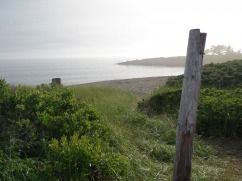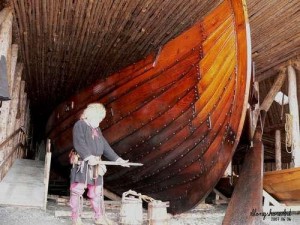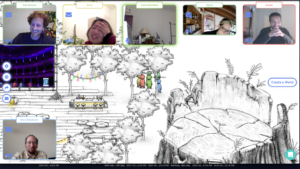
Thanks to the hermit, Tuesday, Sept. 11, 2001 will be memorable to me even without the catastrophe that branded the date—”Nine Eleven”—into history.
The weekend leading up to Nine Eleven started in the dashing fashion typical of that eventful 2001 for me. Anja Brüll and I left Concord, Mass. early Friday evening, driving through the dark to the Harvard Forest center in central Mass. to meet my friend Bob, Harvard Design School’s landscape-ecology professor, and his class of 25 landscape-architecture students. We showed slides illustrating our version of Design with Nature: Me on landscape-based wastewater-cleaning methods and Anja on her Bio-Dome atrium that sheltered an Eden that could clean water and soil. Anja’s presentation proved far more popular. Who could blame these students? They, like most, were entranced by this tall, lean 31-year-old German with wavy blonde hair and form-fitting pants and jacket who planned to clean the world’s polluted industrial sites with her cooling tower-shaped greenhouses.
Bob thought we were staying the night there, but we left late, driving for hours down dark country roads to the highway and more dark roads to Brunswick, Maine, passing a brightly lit subsection of a 9-floor steel ship under construction at the Bath shipworks, turning at the “chocolate church” landmark, and pulling up to a charming 18th-century house to meet up with my friend Abe Collins and his friend Mike. We found them in the kitchen at 2 a.m. nibbling grapes and cheese, and giggling. Abe and Mike were either inebriated or high or both, but Mike sobered up to give us a tour of the charming sea captain’s house in which he grew up. In the morning, we piled into Abe’s beat-up Isuzu truck, stopped for blueberry scones and drove on to our destination and Mike’s inheritance: Hermit Island.
Hermit Island is a spit of land connected by a causeway to one of Maine’s several archipelagos that extend into Casco Bay. The 255-acre private island is owned by Mike’s family, and he and his cousin will one day inherit it. For now, it is open for visitors who camp there. We dropped our gear in a sunny, spacious loft above the island’s camp store and office. A huge ship model hung on the wall over a couch. Mike said a relative had used this as a bachelor pad and had plans to turn it into a restaurant but never did. Mike was only visiting; he lived in Nevada on an Indian reservation where he helped native Americans protect their land and water from expanding mining operations. Abe had met him when he lived on a Navajo reservation promoting permaculture practices. Abe returned to his Vermont hometown in 1999 in hopes of finding better luck promoting his grass-fed agriculture principles. That’s where I met him at a solar-energy festival.

Hermit Island is a microcosm of Maine. With its piney hills, traditional maritime industry, and sandy beaches, there’s almost no reason to drive further north; it’s all there. We walked past campsites and over to a lobster farm (lobster pound) where the owner showed us how they grow thousands of lobsters in a series of pools to ship to for markets all over the U.S. From there, we walked to a wooden boatbuilder shop which a few years before had constructed the Snorri, a replica of the ship Vikings were thought to use to cross the Atlantic to Nova Scotia. Hodding Carter and a crew sailed the Snorri on a challenging and bumbling trans-Atlantic voyage about which he wrote a book.
We brought lobsters back to the loft, and Abe discovered he had no tonic water to mix with the gin he brought, so he picked some fuzzy clusters of sumac blossoms and soaked them in water to make a tart mixer. I was impressed. It was around this time I became certain I was outclassed by Hermit Island, its industries, and my companions. Abe was as notable as Anja: loquacious, intense, bright and well spoken, all in a 28-year-old solid young man who often sang and manically spun ideas (we called him “manic expressive”). Mike was darker, more somber, with long dark hair to match. Sometime in the evening when we were talking about popular songs, Mike learned I was 36, a full 7 years older than him. This seemed to rankle him nearly to the point of disgust. And although I found this amusing on the surface, my thoughts thereafter were dominated by my mortality and ragingly advancing age. Hermit Island suddenly seemed like a panorama of the last 300 years of civilization in which I had to justify my place. Gin and sumac cocktails did nothing to lift my spirits, and I conked out on the couch, looking up at the huge ship model that hovered over me on the wall shelf, knowing I would awake and hit my head on it when I arose.
(Which I did the next morning.) We packed food and continued the hike around the island’s coastline, stopping in pocket beaches where shallow water warmed in the sun made swimming the usually-frigid Atlantic inviting. Anja vigorously swam a half mile from shore, as we watched. We hiked up the hill at the center of the island and picked gnarled apples from stunted trees Mike said were planted by the island’s namesake, the hermit who fished and farmed there in the late 1600s. I looked around and tried to imagine surviving on fish, sheep, and apples in winters with just a fireplace to keep warm. I felt awe and admiration for the hermit, who managed to stay alive in ways I did not know how. Mike kicked at wood shards, perhaps remnants of the hermit’s house. He planned to build a cabin there one day, he reported uncertainly. It occurred to me that Mike, too, was considering his next steps and what would be his legacy here at his inheritance and the pieces of the hermit’s home. We cooked over a fire that night and unrolled our sleeping bags outside to watch the stars that filled a third of the sky. Abe, Mike, and Anja poked at the flames, as Abe ebulliently detailed the methods humans could use to repair ecosystems by changing their ways of farming food and energy. Mike countered each point with examples of how humans were too extractive, incapable of changing their ways to deploy Abe’s vision, and generally doomed. Anja interjected to correct both men’s scientific points, then posited that climate change was the result of interrupting water cycles that cool the planet. Their discussion was a cross between a Carl Sagan narrative and the film “My Dinner with Andre.” I lay on my sleeping bag listening, while watching the sky for shooting stars.
The next day we walked, grilled fish, and swam some more. Mike had me check out the island’s public toilet facilities, which were conventional toilets that flushed to large septic systems. He said his uncle had tried several types of alternative toilet systems, from “Sky Toilets” (more on that another time) to oil-flush toilets. We agreed to conduct a composting toilet workshop on Hermit Island the following summer. I was already selling a few composting toilets to the nearby town of Phippsburg, where pit latrines were legal. Anja and I had planned to drive back to Concord that night so we could be at the office the next morning, but we assured each other we would stay that night and leave promptly at 6 a.m. the next day, just in time to arrive when the office opened.
At 6 the next morning, Anja turned off her travel alarm, turned to look at me, and we both plopped back on our pillows, dozing to the sound of waves as the white Maine sun burned through fog and lit the room. About 9 a.m. that Tuesday, Sept. 11, we finally stuffed all our gear into the back of my old Mazda hatchback and reluctantly drove off.
Two or three hours later, around the North Shore of Massachusetts, traffic suddenly slowed to a crawl on Route 95, a 4-lane highway. A backup like this was far too late to be rush hour, I told Anja. It must be an accident—drivers seemed to be looking out their windows at other drivers, puzzled. They must hear about an accident on the radio, I thought, but we couldn’t confirm that with my broken car radio. Anja worried her employer would be angry at her late arrival, so she found my road atlas and charted a course off the highway and on to small roads to Concord. Two hours later, we parked at the office. As we walked to the door, Lori and Varuni, two young engineering assistants, ran out the open doorway. “We’ve been attacked!” Lori nearly shouted, wide-eyed. Varuni clarified: “Planes bombed New York City.” Anja looked at me, brows furrowed, as if I should explain this on behalf of the United States. We went in and sat by the radio. My only thoughts were “amazing this hasn’t happened before, interesting it happened on my shift.” I also assumed the U.S. financial markets would plunge, zipping my small retirement and bank accounts to zero. And I felt guilty, like somehow our time on Hermit Island had been a deceptive vacation from the realities we had to reconcile.
For the week after that, we went on as always, but the radio stayed on all day. The young folks in the office would opine that Osama bin Laden didn’t exist; he was a made-up target. Seeking ideas for next steps, Varuni and Lori attended a Noam Chomsky rally at which he only asked the audience what they were going to do in the wake of this event. (Great leadership, Noam.) Dave installed a U.S. flag windsock on the roof, and the rest of us discussed what exactly the U.S. flag meant in this context, with the German-born Anja warning against getting overly jingoistic as a response. The intensive mourning for the lives lost seemed odd to me only in light ofs the thousands of lives lost every day meaninglessly. But in this case, they were Americans in the wrong place at the wrong as any of us could have been. We could no longer be hermits snug in safety amid the world’s angst.
Postscripts:
The following month, I was to fly to Kwajalein atoll in the Pacific (with a layover in Hawaii) to attend a SOPAC meeting to discuss water and sanitation solutions for the islands. I anguished over whether to cancel my flight as so many people were doing back then. I decided the risk was relatively low, and boarded a plane half full of Pacific islanders and black-clad government employees with Halliburton briefcases. On my return trip, I spent two days in Oahu which was quiet, with many hotels and guest houses empty.
Anja returned to Germany to her shambling candlelit castle, flew back to Concord to work for a year making a Solar Aquatics system, and then settled back in her hometown of Aachen where she recently gave birth to a son. She is pictured in my book, Liquid Gold.
I don’t know where Mike is. (I’m not absolutely sure “Mike” was his name.) Every year, I aim to go back to Hermit Island, but I have not.
Abe put his farming practice philosophies to work at a northern Vermont dairy farm. He lectures worldwide about how farming can effectively sequester carbon. Here’s a recent video.
Bob is a professor at Nova Scotia Agricultural College. He travels around the world much of the year following ancient pilgrimages and old canal routes. Lori is an engineer in Boston and Varuni is a schoolteacher in New York City.
I suspect I have photos of this trip, but they are not showing up in my photo boxes today. But in researching this post, I found several useful old photos, great Web sites about the Snorri and Hermit Island, and some intriguing books by Hodding Carter (who, it turns out, is a friend of Richard, the bird guy, about whom I’ll write later).
I guess it’s all about the journey.
